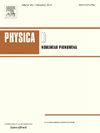Spatiotemporal dynamics of immune responses to viral infection and re-infection
IF 2.7
3区 数学
Q1 MATHEMATICS, APPLIED
引用次数: 0
Abstract
To test the hypothesis that the chemotactic movement of immune cells is pivotal in controlling within-host viral infection and re-infection, we formulate a chemotaxis model with multiple chemokines and spatial heterogeneity to investigate spatiotemporal dynamics of immune responses. The system admits globally bounded classical solutions in one-dimensional space, and the global classical solvability is derived in a high-dimensional space. We discuss the existence and local stability of four equilibria in the homogeneous case. By constructing Lyapunov functionals, we prove the global stability and the convergence rates of equilibria. Numerical simulations verify the theoretical results and provide additional insights. With stronger chemotaxis, the fluctuation of viral load in the early stage of viral infection is significantly reduced and enters a stable state faster, which indicates that chemotaxis can inhibit viral infection. During re-infection, the chemotactic movement of memory CTLs is more important than that of effector CTLs, and vice versa in initial infection. Furthermore, spatial heterogeneity, due to different patients or organs, should inevitably be considered to guarantee the success of clinical treatments.
求助全文
约1分钟内获得全文
求助全文
来源期刊

Physica D: Nonlinear Phenomena
物理-物理:数学物理
CiteScore
7.30
自引率
7.50%
发文量
213
审稿时长
65 days
期刊介绍:
Physica D (Nonlinear Phenomena) publishes research and review articles reporting on experimental and theoretical works, techniques and ideas that advance the understanding of nonlinear phenomena. Topics encompass wave motion in physical, chemical and biological systems; physical or biological phenomena governed by nonlinear field equations, including hydrodynamics and turbulence; pattern formation and cooperative phenomena; instability, bifurcations, chaos, and space-time disorder; integrable/Hamiltonian systems; asymptotic analysis and, more generally, mathematical methods for nonlinear systems.
 求助内容:
求助内容: 应助结果提醒方式:
应助结果提醒方式:


